February 10. ASWAN "Tour of Abu Simbel and Philae" (or the "Great Bus Race") Our tour left an the evil early hour of 3:30 am, due to the government requirement that tourists be taken to Abu Simbel in a police convoy. That didn't adequately explain the early hour but we were told the desert was too hot in mid day. There was another tour group waiting when we got downstairs. After they loaded up on their bus, pillows and all, our smaller bus arrived. The hotel gave us a breakfast box to take with us and, out of the seats left, we chose the two front ones behind the driver The bus made a few more stops before it was filled up to the fold out seats down the middle. We must have hit every backpacker place in Aswan. Then we queued up for the "convoy". their bus, pillows and all, our smaller bus arrived. The hotel gave us a breakfast box to take with us and, out of the seats left, we chose the two front ones behind the driver The bus made a few more stops before it was filled up to the fold out seats down the middle. We must have hit every backpacker place in Aswan. Then we queued up for the "convoy".
Once I saw how many buses were heading for Abu Simbel I became totally disillusioned. I couldn't imagine how everyone could fit in any one place at a single time! The police directed our bus to wait until 4:30 for the convoy to leave. In the that time they almost filled four lanes of traffic about six buses deep. The bus driver gave a quick lecture about his driving which basically said that he would be going very fast, weaving back and forth , and we just deal with it, or, in other words, if you are scared just get off now. When the police gave word the race, I mean convoy, was off. Race was more like it since the buses spent the next three hours speeding past each other as they went flying across the desert. Our man must have had it floored but his little crappy bus couldn't go as fast as the big tour buses, a fact that seemed to frustrate our driver every time a luxury liner went reeling past him. There must have been police somewhere at the front and back of this crazy sprawl of buses but we couldn't see them. Anyway, we were just too tired and slept with our head bobbing every which way until the sun came up over the horizon, trying to drown out the incessant drone of two travelers behind us.
Three hours out of Aswan we arrived at Abu Simbel and there was a collision of tour groups lined up to enter the site. Our driver looked at his watch and said emphatically that it was seven fifteen and that we WOULD be back at the bus in exactly two hours, repeating himself several time. I held a place in the entrance line while Rob bought tickets but he was delayed and delayed as the numerous tour group leaders 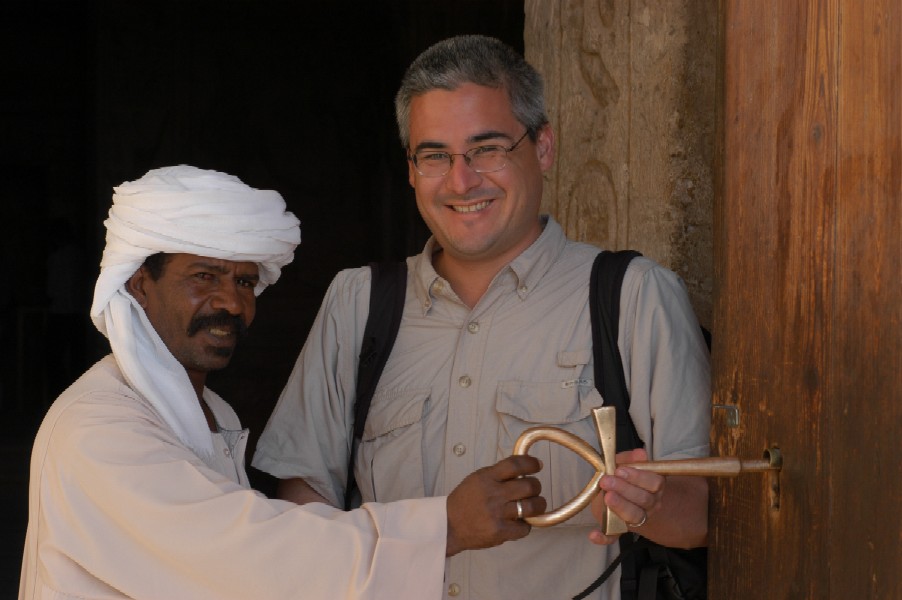 just cut in line to buy their group tickets, blatantly ignoring the voices of dissent from behind them. The whole thing was becoming less fun by the minute. Once inside we tried to separate ourselves from others but it was useless. The independent travelers, like those on our bus, were few and far between. Most people had arrived on massive full-sized plush buses in organized tour groups. Fortunately they had to finish their lecturing before they could go inside the temples. The group leaders were really a nasty bunch. We watched one fat lady leading a French group literally waive a small group of Japanese tourists off of a nearby bench because she didn't want them to listen to her (like they could understand a thing!). It was a obnoxious behavior. just cut in line to buy their group tickets, blatantly ignoring the voices of dissent from behind them. The whole thing was becoming less fun by the minute. Once inside we tried to separate ourselves from others but it was useless. The independent travelers, like those on our bus, were few and far between. Most people had arrived on massive full-sized plush buses in organized tour groups. Fortunately they had to finish their lecturing before they could go inside the temples. The group leaders were really a nasty bunch. We watched one fat lady leading a French group literally waive a small group of Japanese tourists off of a nearby bench because she didn't want them to listen to her (like they could understand a thing!). It was a obnoxious behavior.
Abu Simbel consisted of two temples, the Sun Temple of Ramses II and the Hathor Temple of Queen Nefertari (1304-1237 BC). The Sun Temple was the grander of the two but both had been victimized by the building of the Aswan Dam and had been moved. UNESCO rescued the temples from submersion and moved them to a location along the newly formed Lake Nasser. They move was so well done that they only thing that betrays the authenticity of their present location is the fake mountains that they have been set into. A close look shows the mou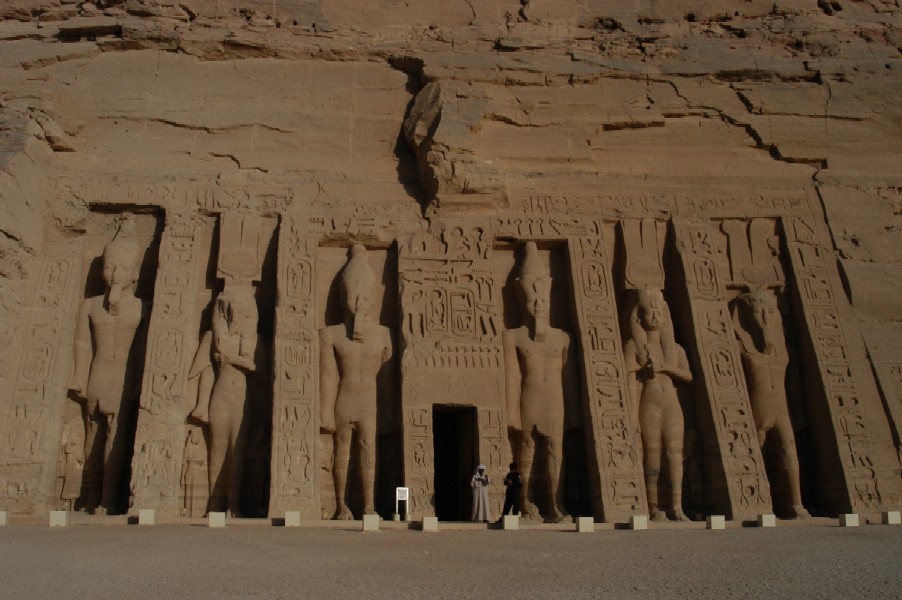 ntains were pieces together with mud bricks. ntains were pieces together with mud bricks.
We first ventured into the Hathor Temple of Queen Nefertari because it was less crowded. The facade was smaller than the Sun Temple but consisted of a greater number of colossal statues. There were six statues of Nefertari and Ramses that each stood about 32 feet high. In this temple Nefertari is associated with the goddess Hathor who was wife to the sun god during his day's passage and mother to his rebirth at dawn. The temple only consisted of four chambers, a hall with Hathor-headed pillars, a vestibule and two smaller chambers.
The Sun Temple of Ramses II (reigned 1279-1213 BC) was like a shopping mall at rush hour during our entire visit so the atmosphere was somewhat diminished but it was impressive, nonetheless. The carvings were amazingly well preserved and showed scenes of Ramses slaying Egypt's enemies while in others offerings are being made to the gods. Ramses pillars lined both sides of the main chamber, off of which extended four other chambers, two of which led to sets of three smaller chambers. It was a fairly elaborate complex to have been carved into the side of a mountain. The enormous seated statues that adorned the front stood 72 feet high. The colossi faced east to greet the sunrise and were all carved out of a single slab of rock. One colossi lost its upper half in an earthquake in 27 BC but otherwise the facade and temple have survived over 3000 years , including a major move, with little serious damage. Looking at it a person has to wonder what will be our monumental legacy 3000 years from now. , including a major move, with little serious damage. Looking at it a person has to wonder what will be our monumental legacy 3000 years from now.
Leaving the temple grounds we passed a slew of souvenir vendors but did our best to keep a distance. Our driver was eager to get moving as soon as we were all loaded up again. He secured a place near the front of the queue and was pleased with himself. Then we just sat for a good half hour before the caravan started to move. It is great to have a driver that cares so much about the quality of your visit that he cuts it short so he has an easier drive back. It was pretty much the same mad race back that we had experienced on the way out; the buses with their peddles floored, dodging, passing, and weaving their way across the desert.
As we neared Aswan the driver informed us that ten people would be changing to a smaller van for the extended tour. We were part of that ten and when we met our new driver I gained a whole new appreciation for our old driver. As preoccupied as our first driver had been with his speeding, this driver was just unfriendly and totally put out to driving us anywhere. Unbeknownst to us our extended tour not only included the Temple of Philae but the Aswan High Dam and an unfinished obelisk. We all passed forward our entrance fee and he sped us to the middle of the dam. "Just five minutes", he said rushing us out of the van. As significant as the dam was as an engineering feat and in terms of impact on the environment (it covered lower Nubia in 200 meters of water) it really isn't a heart stopper to see in person. High Dam and an unfinished obelisk. We all passed forward our entrance fee and he sped us to the middle of the dam. "Just five minutes", he said rushing us out of the van. As significant as the dam was as an engineering feat and in terms of impact on the environment (it covered lower Nubia in 200 meters of water) it really isn't a heart stopper to see in person.
From the dam we dashed over for a rushed hour at the stunning Temple of Philae, neatly rebuilt on a new island after the dam flooded her original home. Getting from the shore to the island meant dealing with motor boat captains that blatantly defied the government posted fees and tried to negotiate unreasonable rates to make the short crossing. They seemed to fail to see how these posted rates might actually protect them instead of us since supply and demand would have suggested that we could get an even cheaper rate if we tried. There was a seemingly endless supply of boats and only a handful of tourists. Finally, one snotty captain reluctantly agreed to the posted rate.
The sun was hitting the front of the temple when we arrived and there were only a few tourists mingling around. For a moment we had a serene and timeless ambiance. 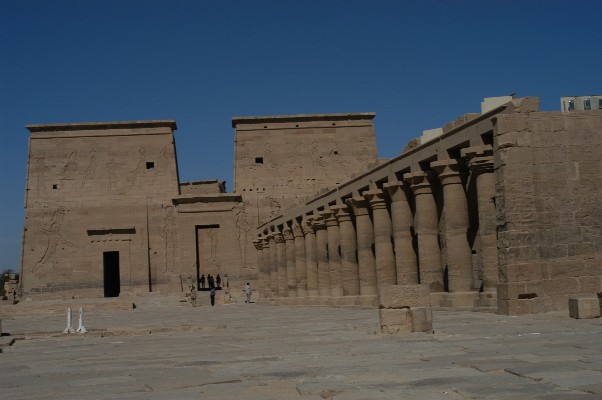 That soon changed but it never reached the crowd density we had just experienced at Abu Simbel. The islands most impressive structure was the austere Temple of Isis, the longest surviving legacy to Egypt's ancient religion. Isis was revered as both a mother goddess and goddess of sexuality. She was the goddess of nature and purity, and the protector of humans. These qualities gave here a dedicated following and allowed her to survive into Egypt's Christian era. Her "kinship" with the Christian mother figure kept Philae alive with worshippers until 6th century, when Emperor Justinian finally replaced her with the Virgin Mary. The carvings inside the temple were fairly well preserved but not as vivid as Abu Simbel and had some visible Napoleonic graffiti. There were other parts of the island to explore as well but our rapid-o-tour didn't allow us time to get that far. That soon changed but it never reached the crowd density we had just experienced at Abu Simbel. The islands most impressive structure was the austere Temple of Isis, the longest surviving legacy to Egypt's ancient religion. Isis was revered as both a mother goddess and goddess of sexuality. She was the goddess of nature and purity, and the protector of humans. These qualities gave here a dedicated following and allowed her to survive into Egypt's Christian era. Her "kinship" with the Christian mother figure kept Philae alive with worshippers until 6th century, when Emperor Justinian finally replaced her with the Virgin Mary. The carvings inside the temple were fairly well preserved but not as vivid as Abu Simbel and had some visible Napoleonic graffiti. There were other parts of the island to explore as well but our rapid-o-tour didn't allow us time to get that far.
Crammed back into our mini van we wasted a good 20 minutes at the unfinished obelisk. We weren't the only ones who weren't thrilled about the opportunity because only three people actually paid to go in. The rest of us just waited. Those were 20 minutes I would have happily spent back at Philae instead. But, tourism in Egypt is very rarely about what you actually want anyway.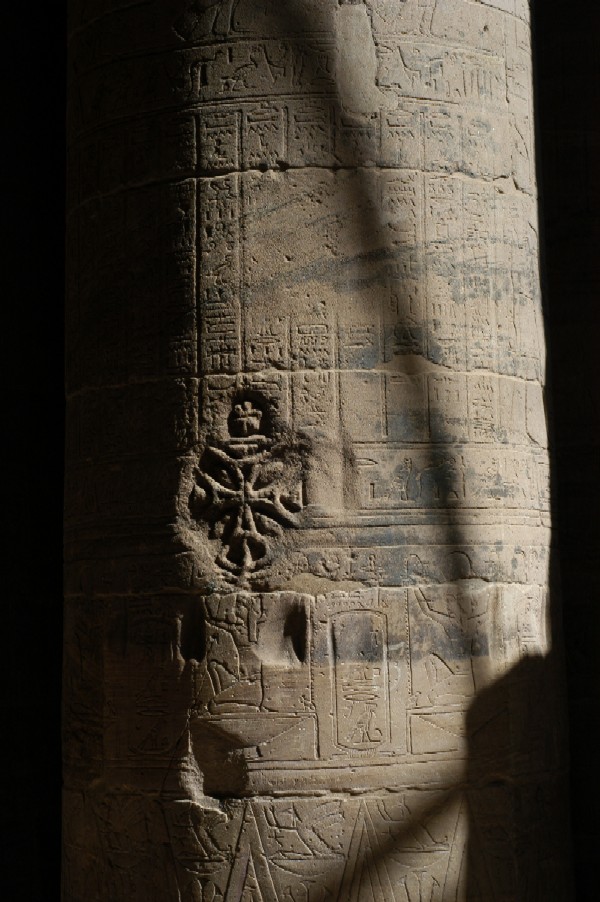
Back in Aswan we cleaned up at the hotel and endured starvation just a bit longer (there was no lunch break scheduled in our 14 hour tour) so we could sort out our train tickets for the following day. There were six trains to Luxor but only three that we could buy tickets on which left us limited departure times. We sucked it up and bought tickets for the 6:30 train. The next option was to take our chances on the 7am train having seats available when we got on or taking a train in the afternoon. Neither of us were in love with the idea of another day hanging around Aswan so 6:30 it was.
Feeling totally famished we caved in and had some local sweets at our station restaurant before catching a cab to the Nubian restaurant. A service taxi was happy to give us a ride for a flat rate which saved us the usual taxi hassle. We arrived at the restaurant in time to enjoy the sunset before dinner. The place swelled as the sun went down and then cleared out entirely. We had our dinner in peace and quiet. Finding a taxi back into town presented a problem. A taxi in the restaurant parking lot agreed to take us but 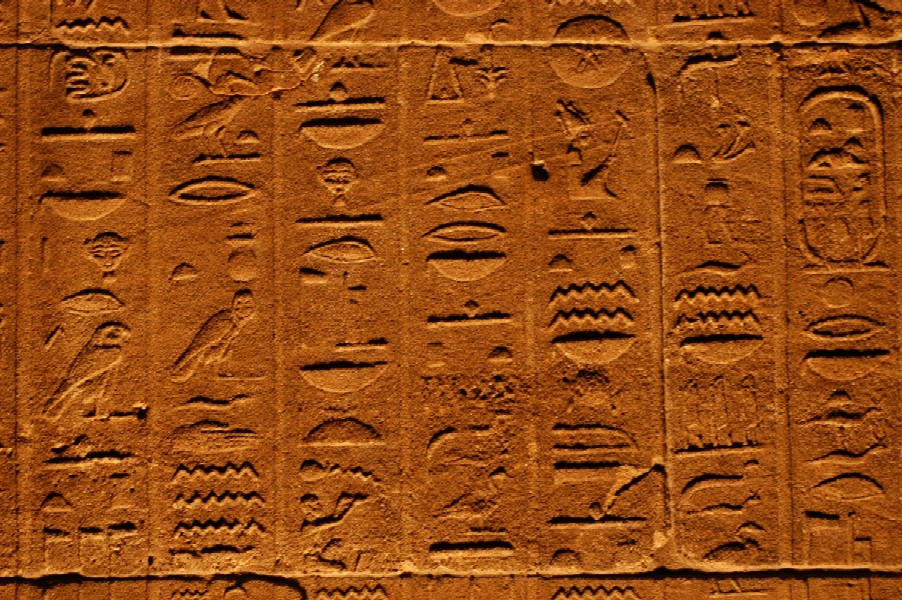 we later realized that he had no idea where our hotel was and when he started to worry that he had abandoned the fair he was waiting for at the Nubian Restaurant he tried to dump us out early or get us to cough up more money. Rob just insisted he take us where he agreed to for the original price. He became downright nasty before we finally got out a couple of blocks before our hotel and just walked. we later realized that he had no idea where our hotel was and when he started to worry that he had abandoned the fair he was waiting for at the Nubian Restaurant he tried to dump us out early or get us to cough up more money. Rob just insisted he take us where he agreed to for the original price. He became downright nasty before we finally got out a couple of blocks before our hotel and just walked. |

